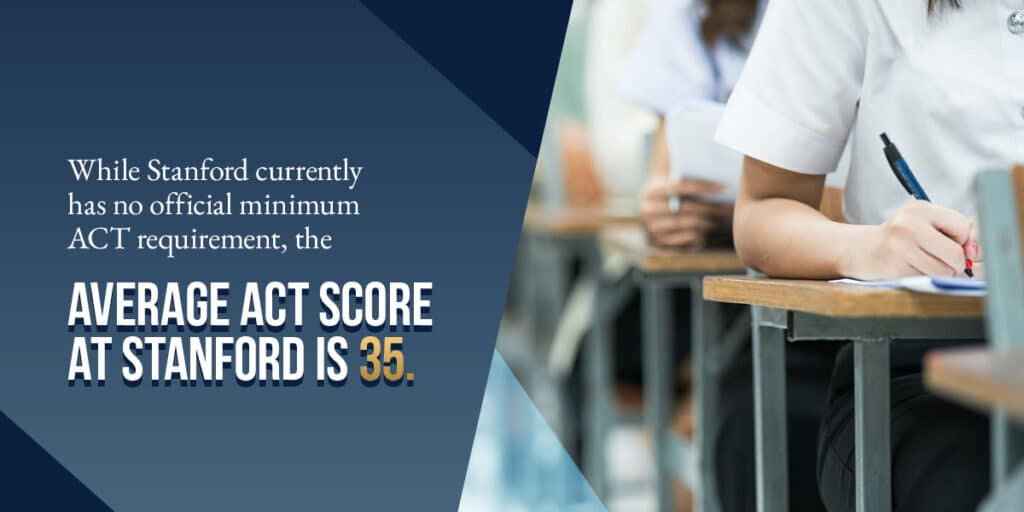How to Get Into Stanford University: Top Questions Answered for 2026 Admissions
Learn how you can get into Stanford University with essential tips on GPA, standardized test scores, essays, and extracurricular activities to improve your chances of admission. Get insights on the application process, requirements, and how to make your profile stand out for Stanford admissions.
Admission to a top university is a prestigious achievement that can unlock a lifetime of academic and career opportunities. That’s why one school, Stanford University, is renowned for its exceptional standards, making the prospect of getting into such a school both exhilarating and intimidating.
Students considering an application to Stanford will have the greatest chance of success when they know what to expect and how to make their application stand out. This guide will explain what it takes to get into Stanford.
How Difficult Is It to Get Into Stanford?
Stanford University has earned a reputation as one of—if not the—most selective universities in the United States. Students who make the cut have exceptionally high GPAs and SAT or ACT scores. Stanford’s admissions rate is only around 3%- 4% across tens of thousands of applicants every year.
Stanford receives between 50,000 and 60,000 applications each year, and in total, only around 1,700 freshmen and 30 transfer students receive admissions offers. Though Stanford does not report exact statistics, it is safe to assume that at least half those 50k+ applicants have unweighted GPAs above 3.8 and SAT scores over 1500. So grades and test scores are important, but grades and test scores alone are not enough to secure admission. With the right approach, you or your high school student could break through.
GPA Requirements for Stanford University
Applicants need exceptionally high grade-point averages to have a viable chance of admission to Stanford. Stanford’s 2024-2025 Common Data Set reports that the average GPA is over 3.9, and 73.3% of admitted first-year students have 4.0 GPAs, so applicants should strive for near straight As to compete among the best.
Taking challenging classes like AP or IB courses will make a high GPA look even more impressive. Most of our students tend to take 5+ AP classes, though that number varies depending on a student’s admission strategy.
Applicants at or below a 3.9 GPA can still achieve admission but should prioritize a higher SAT or ACT score and other dimensions of their application to compete with 4.0 GPA applicants.
Don’t have a 3.9+ GPA? Not taking 5+ AP classes? Students should acknowledge any academic struggles and seek immediate support if they plan to apply to Stanford. Focusing on other aspects of the college application, such as extracurriculars or research could potentially be the difference between being accepted and being rejected.
SAT and ACT Scores
Stanford has had no official requirement for SAT or ACT scores in recent years but is reinstating a standardized testing requirement for the 2025–2026 application cycle. When this requirement comes into effect, students may submit either an SAT or ACT score.
The average SAT score at Stanford is 1540/1600, and the average ACT score is 35, so taking the SAT/ACT and achieving a 1540 SAT/35 ACT or better can translate into a strong application. Students can take the SAT/ACT test times to improve their scores, and Stanford will consider the best scores to report for each section, focusing on Reading, Writing, and Math scores.

If a student takes the ACT multiple times, Stanford will accept their “superscore” by combining their best subscores from each section within the ACT. Taking the ACT several times, focusing their prep on a different section each time, and submitting the best scores for each component is an effective strategy for admissions.
Beyond GPA and Test Scores
But GPA and test scores only tell part of the story. The typical admitted Stanford student will show the ability to make significant and creative contributions outside the classroom. In comparison with other East Coast Ivies, Stanford is culturally more geared towards creating and catalyzing solutions than in abstract contemplation. This can be seen in their mission statement when they emphasize 4 key areas:
- Sustaining Life on Earth
- Accelerating Solutions for Humanity
- Catalyzing Discovery in Every Field
- Preparing Citizens and Leaders
Each of these sub areas prioritize active verbs about a thing that students are doing. If all a student is doing is studying for the SAT and getting good grades, then that student isn’t yet doing enough to show an ability to creatively lead and effectively catalyze change.
Now, the “solutions” focused nature of Stanford’s cultural legacy as an engineering institution does NOT mean that they are just looking for “practical engineering types.” Stanford expects sensitivity and reflection and collaboration among the leaders and solution-makers that it invites into its campus. They don’t just want to know that you’ve engineered the “most efficient solution”; they want to know how you’ve critically defined efficiency and how you have been thoughtful about the specifications that you’ve offered. For example, if you started to design a headset to aid the visually impaired, have you partnered with multiple different people in the visually impaired community to gather feedback and fine-tune the features that you decided to include?
Design thinking, as a principle, is something that has percolated throughout Stanford as an institution. This means that even if a student is applying as a humanities and social sciences major, they should be implementing some of the ideas and weaving them–artfully–into application essays. As the Stanford Design School (or d.school) states:
- “The nature of design affords people the opportunity and privilege to shape the world that they-and others-inhabit. This is power. In a just world, that power is shared, prioritizing the voices and ideas of people most impacted by the intended and unintended effects of new designs. We aim to actively confront and challenge the mindset that design can only be used by a privileged few.”
What this means, in practical terms, for a student’s extracurriculars and application is that no matter how a student is deploying their innovation and creativity, they should be able to think critically about the impact that those innovations will have.
Other Requirements for Stanford University
Besides GPAs and SAT or ACT scores, factors that can influence a Stanford application’s outcome include:
- Personal statement: The Stanford application form includes submitting the Common Application’s Personal Statement, a 650-word essay that is required for most schools and will be the same for each. The goal of the essay is to bring a fundamentally human element to one’s application. The Personal Statement should speak to one’s quantitative and qualitative strengths, show a sense of critical thinking, celebrate accomplishments, and communicate personality. This is the one place on the Common Application where students get to show who they are (and who they hope to become) in their own words, with their own voice.
- Supplemental Essays: Students will be required to answer a variety of short questions (limit 50 words each) and short essays of 250 words maximum. Applicants should aim to convey their background, merit, and motivations in a compelling narrative. It’s worth writing and reviewing several drafts to refine this component.
- Letters of recommendation: Stanford requires letters of recommendation from two teachers and a guidance counselor. Teachers and counselors receive a link to submit their letters to Stanford, so students may not get to read the letters themselves. Applicants should choose teachers from two different subject areas who know them well and can share complementary perspectives on their strengths.
- Extracurriculars: While Stanford prioritizes academic excellence, it also considers activities outside the classroom. Strong applicants have a deep commitment to a couple of sporting, cultural, or community activities that they balance well with academic pursuits. Stanford values depth of commitment and height of achievement in extracurriculars over sheer breadth of interests.
- Location: Stanford enrolls students from all 50 states and many countries around the world. Applicants from underrepresented states are attractive as Stanford embraces geographic diversity.
- Interviews: Stanford offers conversational interviews to some applicants. Acceptance is possible without an interview, but applicants who receive interview opportunities should aim to set themselves apart by making a strong, positive impression.
Stanford Admissions Processes
Stanford offers a few different application deadlines:
- Restrictive Early Action: This option comes with an earlier application deadline — November 1 instead of the regular decision deadline of January 5. For students with strong SAT or ACT scores who know Stanford is their top choice, taking this option could be wise. Note that applying Restrictive Early Action will keep the student from being able to apply for the binding Early Decision options that many other schools (like Johns Hopkins or the University of Chicago) offer. Binding Early Decision options will also usually offer a larger benefit for a student’s admissions chances than Stanford’s Restrictive Early Action option will, so this option should only be chosen if Stanford truly is the student’s first choice school and if the student’s application is exceptionally strong.
- Regular Decision: This is the traditional process that most applicants follow, and is usually due around January 5th.
- Arts Portfolio Deadlines: There is also one final nuance: if an applicant has an arts portfolio (maybe they are a leading young trombonist or have an impressive catalogue of work as an aspiring furniture designer), they will need to submit their application by October 15th for Restrictive Early Action and December 5th for Regular decision.
Consult Zenith Prep Academy to Enhance Your Stanford Application
When applying to a school as competitive as Stanford, every advantage is worth taking. That’s why students who are serious about getting a top-tier education should partner with Zenith Prep Academy.
We are an award-winning college counseling program with a track record of getting students into top schools. As the number-one College Consulting & Education Company in America, applicants partnering with Zenith Prep Academy have seen 500% higher acceptance rates for Ivy League and Top 15 Universities, including Stanford.
We partner with 6th-12th-grade students and their families, meeting them where they are and guiding them to acceptance at either a top university. We know the surprising factors beyond GPAs and test scores that make or break an application, and we back our commitment with a 100% money-back guarantee.
Thousands of parents across the U.S. assure that we keep our word by helping students attend their dream universities. Book a free consultation to learn how we can strengthen your Stanford application.
Decoding Stanford’s Extracurricular Expectations
Knowing how to get into Stanford University means understanding what the admissions team looks for in extracurricular activities. These are not just things to list but chances to show your leadership, character, and impact in your high school and community. Since admission to Stanford University is very competitive, you need to build a strong profile for the college admissions process.
Here are key points to keep in mind when applying to Stanford:
- Show Intellectual Vitality: Demonstrate curiosity and love for learning beyond your classes.
- Display Leadership and Responsibility: Take charge in clubs, sports teams, or community projects.
- Make a Meaningful Community Impact: Show how you have helped others in a real way.
- Maintain Consistency and Commitment: Stay involved in activities over time, not just briefly.
These qualities help you stand out by showing your experiences and your character. Students who get college acceptance usually have a true passion for their activities along with good academics.
How to Showcase Leadership and Impact in Extracurriculars
When applying to Stanford, it is important to show leadership and the effect of your work in extracurricular activities. The admissions officers want to see students who have taken responsibility and made a difference in their school or community.
To showcase your leadership and impact effectively:
- Name Your Roles Clearly: Explain your positions and what you did.
- Give Numbers or Results: For example, “Led a 20-member team” or “Raised $5,000 for a cause.”
- Explain Your Initiative: Describe how you spotted a problem and worked to solve it.
- Share What You Learned: Talk about how these experiences taught you about responsibility and character.
Using these tips in your college application will make your story stronger. This helps you stand out in the college admissions process and increases your chances of admission to Stanford University.
Stanford’s Preferred Extracurricular Activities: STEM, Arts, Community Service, and More
| Activity Type | Description | Why It Helps in Admissions |
|---|---|---|
| STEM | Research, science contests, coding clubs | Shows intellectual vitality and creativity |
| Arts | Music, theater, visual arts | Reflects creativity and personal growth |
| Community Service | Volunteering, nonprofit work | Shows empathy, leadership, and positive impact |
| Sports and Athletics | Team or individual sports | Demonstrates teamwork, discipline, and resilience |
Being involved in these activities, especially with leadership and deep participation, supports a strong application. Stanford’s low acceptance rate shows the importance of pairing academic strength with genuine extracurricular interest.
Maximizing Impact: Fewer Activities, Exceptional Achievement
Many think having many activities is better for college applications. For Stanford and other selective schools, having fewer activities but outstanding achievements is more valuable.
Try these tips:
- Focus Deeply: Spend more time on activities where you can lead and contribute significantly.
- Get Leadership Roles: Work toward higher responsibilities in your chosen activities.
- Show Long-Term Involvement: Prove that you have stayed committed over time.
- Highlight Achievements: Point out awards, honors, or clear results from your work.
This focused approach helps you stand out by showing responsibility, initiative, and steady effort — qualities important for college acceptance. It fits well with Stanford’s focus on intellectual vitality and true community impact.
Demonstrating Genuine Passion Through Extracurricular Involvement
Authenticity matters when applying to Stanford University. Admissions officers want to see real passion and motivation in your extracurricular activities. Your personal statement and essays are great places to share your true voice.
To show genuine passion:
- Be Honest and Thoughtful: Explain why certain activities matter to you.
- Tie Interests to Growth: Describe how your involvement changed your character or goals.
- Use Stories: Share specific examples that show your excitement and dedication.
- Stay Consistent: Make sure your activities match your academic and career interests.
Showing true commitment helps your application connect with admissions officers. When your actions and story fit together, it makes your entire application stronger during the college admissions process.
Have questions about standing out in your Stanford application?
Contact Zenith Prep Academy for personalized help with your college application.
Sources:
- Stanford University Office of Undergraduate Admission. (2024). What We Look For. https://admission.stanford.edu/apply/what-we-look-for.html
- National Association for College Admission Counseling. (2023). Extracurricular Activities and Leadership. https://www.nacacnet.org/news–publications/publications/extracurricular-activities/
Mastering the Stanford Application Essay
Applying to Stanford University involves more than just good grades; your application essay plays a big role. The Stanford university application process focuses heavily on personal essays to learn about who you are, how you think, and if you fit with the school. Writing a well-thought-out essay can make you stand out in the competitive Stanford admissions process.
Important points to keep in mind for the Stanford application essay:
- Share honest personal experiences and ideas.
- Write clearly and correctly, without grammar mistakes.
- Answer the essay questions carefully and clearly.
- Avoid common errors that weaken your personal statement.
Focusing on these points will help you write an essay that shows your true self and increases your chances of admission.
Common Essay Mistakes and How to Avoid Them
Many students make simple mistakes when working on essays during the Stanford university application process. Knowing these mistakes can help you improve your personal statement.
Common errors include:
- Lack of focus: Not answering the question or going off-topic.
- Using clichés: Writing phrases that sound ordinary instead of original stories.
- Poor organization: Mixing ideas in a confusing way.
- Grammar and spelling mistakes: These make the essay look careless.
- Wrong essay length: Writing too much or too little compared to Stanford’s limits.
- Failing to show your uniqueness: Not highlighting what makes you different or curious.
To avoid these mistakes:
- Plan your ideas before writing.
- Use specific examples from your life.
- Check your essay carefully, or ask teachers for feedback.
- Follow all rules set by Stanford University about the essay.
Fixing these issues will make your essay stronger and better reflect who you are.
Writing a Standout Stanford Essay: Tips and Strategies
Writing a great essay for Stanford means being prepared and using smart writing tips. Your goal is to show who you really are and how you belong at Stanford.
Try these advice points to improve your essay:
- Be honest: Write sincerely about your experiences.
- Show your eagerness to learn: Talk about your interests and passions.
- Use simple and clear language: Avoid complicated words.
- Grab attention: Start your essay with something interesting.
- Share your growth: Explain how challenges helped you improve.
- Connect to Stanford’s values: Show how you could add to their community.
- Rewrite your essay: Editing helps make your message clear and strong.
A clear plan and honest writing can help your essay make a strong impression in the Stanford admissions process.
Effective Essay Topics to Highlight Your Strengths
Picking the right essay topics can help you do well in your Stanford application. Choose subjects that allow you to show your best qualities, leadership skills, and curiosity.
Good topics include:
- Personal stories: Times you showed strength or learned important lessons.
- Curiosity: Subjects you enjoy and want to explore more.
- Leadership: Times you took charge and made a difference.
- Your point of view: How your background or experiences add to diversity.
- Achievements: Big successes related to what you care about.
- Passions: Activities that show your creativity and commitment.
These topics help you write essays that explain who you are and why Stanford should choose you.
Stanford Essay Requirements: Length, Number of Essays, and Prompts
| Item | Details |
|---|---|
| Number of Essays | Usually 1 or 2 essays, depending on the year. |
| Essay Length | Each essay should be between 250 and 650 words. |
| Essay Prompts | Questions that ask about your personality, goals, and interests. |
| Format | Typed, double-spaced, using standard fonts like Times New Roman (12 pt). |
| Submission | Submit through Stanford’s application portal by the deadline. |
Always check Stanford’s official admissions website for the latest essay prompts and dates. Following these instructions shows you pay attention to details and respect the process.
Zenith Prep Academy offers expert advice to help with the Stanford admissions process. For personalized guidance, learn more about our college application tips.
Frequently Asked Questions (FAQ)
Q1: How important are essays in the Stanford admissions process?
Essays are very important. They show who you are beyond your grades and test scores.
Q2: Can I submit more than one essay for Stanford?
Stanford usually asks for one or two essays. Extra essays might not be accepted.
Q3: What common mistakes should I avoid in my Stanford essay?
Avoid vague answers, ignoring the question, grammar errors, and not showing what makes you unique.
Q4: How do I pick the best topic for my essay?
Choose topics that show your strengths, interests, and growth, and match Stanford’s values.
Q5: Where can I find the latest Stanford essay prompts and rules?
Check Stanford’s official admissions website often for updates.
Navigating Stanford’s Financial Aid and Tuition
Estimating Your Financial Aid Package: A Step-by-Step Guide
Knowing how to estimate your financial aid package is important when planning to attend Stanford University. Financial aid, including scholarships and grants, can help lower the cost of tuition fees and other expenses.
To estimate your aid eligibility and financial aid package, follow these steps:
- Gather Financial Information: Collect income statements, tax returns, and other financial documents to provide accurate information.
- Use Stanford’s Aid Calculator: Stanford offers an online aid calculator that helps prospective students estimate their financial aid based on family income and assets.
- Complete the Financial Aid Application: Submit required documents such as FAFSA and CSS Profile to apply for financial aid.
- Review Your Estimated Aid Package: After submitting applications, Stanford’s financial aid office will send an estimated aid package showing grants, scholarships, and loans.
- Consider Tuition Fee and Other Costs: Include tuition fee, housing, meals, and other expenses when calculating your total cost.
Following these steps helps applicants understand costs and aid availability early in the college admissions process.
Exploring Merit-Based Scholarships at Stanford
Merit-based scholarships provide funding separate from need-based financial aid. Stanford University offers merit scholarships to recognize academic achievements, leadership, and other talents.
Key points about merit scholarships at Stanford include:
- Awarding Scholarships: Stanford mainly focuses on need-based aid, but some departments and outside organizations offer merit scholarships.
- Scholarship Applications: Applicants should research scholarship options and meet all deadlines during the college admissions process.
- How to Get Scholarships: Show strong academic records, leadership skills, community service, or special talents in your applications.
- Financial Support: Combining merit scholarships with other financial aid can help build a solid plan for funding your education.
Students should research available Stanford scholarships to reduce reliance on loans.
The Stanford Financial Aid Application Process: A Comprehensive Overview
Applying for financial aid at Stanford requires attention to detail and timely submission of documents. Knowing what is needed and when to submit helps avoid delays.
The application steps include:
- Submitting FAFSA and CSS Profile: Both forms are required to assess financial need.
- Providing Supplementary Documents: This includes essays, transcripts, and any other materials requested by Stanford’s financial aid office.
- Meeting Deadlines: Submit all materials on time. Late submissions may cause delays or reduced aid.
- Following Application Requirements: Complete every part of the financial aid application carefully.
- Tracking Submission Status: Use Stanford’s online portal or communications to confirm your application status.
Completing these steps properly increases the chance of receiving financial aid on time.
Understanding Typical Living Expenses for Stanford Students
In addition to tuition fee and financial aid, students should consider living expenses at Stanford University. California’s cost of living affects housing, food, transportation, and other daily costs.
Typical student spending includes:
| Expense Category | Estimated Monthly Cost | Notes |
|---|---|---|
| Housing | $1,200 – $2,000 | On-campus dorms or off-campus housing |
| Food | $300 – $600 | Meal plans or groceries |
| Transportation | $50 – $150 | Public transit or car-related expenses |
| Personal Expenses | $100 – $300 | Books, supplies, entertainment |
When budgeting for college, include these living costs along with tuition fee and other expenses. Good planning helps students manage money while focusing on their studies.
Beyond Academics: Unveiling Stanford’s Holistic Review
Demonstrating Intellectual Curiosity: Key Strategies
Admission to Stanford University is not just about standardized test scores, GPA, or exams. The Stanford admissions process focuses on intellectual vitality and curiosity as important parts of a candidate’s academic profile. Showing real passion for learning, exploring new ideas, and solving problems can help your application stand out.
Here are key ways to show intellectual curiosity:
- Engage in Research: Mention any research projects, independent studies, or science fairs where you went beyond classroom learning.
- Show Passion in Essays: Use your essays to explain how your academic interests have grown and how you want to explore them at Stanford.
- Problem Solving and Critical Thinking: Share examples of challenges you faced, either in school or in your personal life, and how you solved them.
- Join Academic Activities: Take part in clubs, competitions, or special courses that show your dedication to learning.
The Stanford university admissions team looks for students with a strong desire to learn and explore. This intellectual vitality shows you are ready for Stanford’s challenging academic setting.
The Importance of Strong Letters of Recommendation
Letters of recommendation are very important in the college admissions process, especially for Stanford University applications. These letters provide trustworthy insights into your character, personal qualities, and academic potential that grades and test scores cannot fully show.
To get strong letters of recommendation:
- Pick the Right Recommenders: Choose teachers and counselors who know you well and can honestly describe your strengths and growth.
- Give Background Information: Share your resume, achievements, and goals with your recommenders so they can write detailed and personal letters.
- Highlight Personal Qualities: Recommendations should mention traits like leadership, hard work, teamwork, and honesty.
- Prepare for Interviews: If your application includes an interview, doing well can add extra support.
Strong recommendation letters act as supporters for you, boosting your credibility and showing why you fit well at Stanford.
Showcasing Your Unique Qualities and Personality
Stanford university admission values being yourself and showing your true personality. Besides grades, sharing your unique qualities can improve your chances of acceptance.
Try these tips:
- Use Essays and Personal Statements: Tell stories that show your leadership, creativity, and special experiences that shaped you.
- Highlight Extracurriculars: Share your community service, clubs, or other activities where you took initiative and made a difference.
- Show Self-Reflection: Talk honestly about your strengths and challenges to demonstrate your growth and resilience.
- Be Authentic: Being genuine helps the admissions team see the real person behind your academic records.
By being open and honest, you give a full picture of what you will bring to Stanford’s campus.
Addressing Common Misconceptions About Stanford Admissions
Many students have wrong ideas about applying to Stanford. Knowing the facts can help you prepare better.
Common myths and truths:
| Myth | Reality |
|---|---|
| You need perfect test scores and GPA | Stanford reviews the whole application. Scores matter but aren’t everything. |
| You must have extraordinary extracurriculars | Quality and impact are more important than having many activities. |
| Essays are not very important | Essays are key to showing your curiosity and personality. |
| The acceptance rate means you can’t get in | Although it’s competitive, strong applications aligned with Stanford’s values have a chance. |
Stanford looks carefully at your academics, essays, recommendations, and personal qualities to create a balanced class.
A Strategic Approach to Your Stanford Application
The Value of Professional Guidance for Your Stanford Application
Applying to Stanford University is a highly competitive process that requires a clear strategy and expert support. Professional guidance can help you handle the college admissions process more effectively. Experts who know Stanford admissions well offer advice on every part of your application, including essays, interviews, and recommendation letters.
Benefits of professional guidance include:
- Better Application Quality: Experts help improve your essays and personal statements to make them clear, strong, and aligned with Stanford’s expectations.
- Smart Planning: Advisors show you how to highlight your strengths and intellectual curiosity in the best way.
- Full Support: Guidance covers interview preparation, getting strong recommendation letters, and polishing all parts of your application.
- More Confidence: With expert help, you can approach the application process with a strong, confident plan.
If you ask, how can I get into Stanford University? expert advice is one of the best ways to improve your chances. Experienced professionals understand the admissions process and can review your profile to make your application stronger.
Essential Resources to Enhance Your Application
Using the right resources when applying to Stanford University can improve your application and help you stay prepared. Here are important tools and platforms to use:
- Application Checklists: Keep track of tasks like writing essays, submitting test scores, listing extracurricular activities, and collecting recommendation letters.
- Essay Writing Guides: Find tips to write genuine and compelling essays that fit Stanford’s questions.
- Extracurricular Planning: Use resources to find and grow activities that show leadership and intellectual curiosity.
- Scholarship Information: Look for scholarships available to Stanford applicants.
- Test Preparation: Use study guides and online tools to reach competitive test scores.
- Online Platforms: CollegeVine, Yocket, and Crimson Education offer guidance, application tools, and support for students applying to selective schools.
- Research Materials: Get updates and details about Stanford’s admission rules from official sources.
Using these resources along with expert advice gives you a solid base to build a strong Stanford application.
Creating a Realistic Timeline for Your Stanford Application
Good planning and time management are key when applying to Stanford. Making a realistic timeline helps you finish each part of your application on time and well done. Follow this suggested timeline:
| Milestone | Recommended Deadline | Notes |
|---|---|---|
| Research & Preparation | 12 months before submission | Start early to understand requirements and resources |
| Standardized Tests | 9-10 months before deadline | Take tests like SAT or ACT early |
| Essay Drafting | 6-7 months before deadline | Begin early to allow time for revisions |
| Recommendation Requests | 5-6 months before deadline | Ask recommenders early to give them time |
| Final Submission | At least 1 week before deadline | Submit before the deadline to avoid issues |
To manage your timeline well, set reminders, mark deadlines on a calendar, and try to submit early when possible. This approach helps reduce stress and keeps you ready during the application process.
Proactive Steps to Increase Your Chances of Admission
To improve your chances of getting into Stanford University, focus on these steps to build a strong application:
- Strong Academics: Keep high grades and take challenging courses to show your academic strength.
- Meaningful Extracurricular Activities: Participate actively in clubs, volunteering, or research that show passion and leadership.
- Effective Essays: Write personal statements that tell your story, show your curiosity, and explain what you can contribute to Stanford.
- Good Recommendation Letters: Get letters from teachers or mentors who truly know and support you.
- Interview Preparation: Use interviews to share more about yourself and why you fit at Stanford.
- Balanced Profile: Show a mix of academics, leadership, creativity, and personal growth.
- Networking and Mentoring: Talk to current students, alumni, or admissions counselors to get advice and support.
Following these steps helps you match what Stanford looks for in their holistic admissions review. Careful and steady preparation will help you stand out.
Frequently Asked Questions (FAQ)
Q: How important is professional guidance in applying to Stanford?
A: Professional guidance can improve your chances by helping you create a strong application and understand admission rules clearly.
Q: What resources should I use to improve my Stanford application?
A: Use checklists, essay guides, test prep materials, and trusted platforms like CollegeVine and Crimson Education for full support.
Q: When should I start preparing my Stanford application?
A: Start at least 12 months before the deadline to have enough time for research, test prep, essay writing, and getting recommendation letters.
Q: How can I increase my chances of admission to Stanford?
A: Focus on strong academics, meaningful extracurriculars, well-written essays, strong recommendations, and good interview preparation.
For more details on the college admissions process, visit our comprehensive college application strategies guide.
What are the key requirements for admission to Stanford University and other top California schools?
Admission looks at several factors: high standardized test scores like SAT or ACT, a strong GPA with challenging courses, notable extracurricular activities, well-written essays, and recommendation letters. Schools want students who show intellectual curiosity and leadership.
How competitive is the acceptance rate at Stanford and other California universities?
Stanford’s acceptance rate is very low, around 4%. Other top California universities also have tough admissions due to many applicants. Applying early can help a little, but candidates still need a strong application.
Can international students apply to California universities including Stanford?
Yes, international students can apply and must meet the same academic requirements. They also need to prove English proficiency through tests like TOEFL or IELTS. After acceptance, they must meet visa rules.
What is the eligibility criteria for Stanford University in terms of academics and test scores?
Applicants usually need a high school diploma or equivalent, SAT or ACT scores within Stanford’s middle 50% range, and good results in advanced classes like AP or IB. Transcripts and test scores are essential.
What should students know about college applications and admissions in California universities?
Students should apply through platforms like the Common App or individual university sites. Deadlines vary between early action (usually November 1) and regular decision (around January 1-15). Essays, transcripts, and recommendation letters are required.
| Application Type | Deadline | Notification Date |
|---|---|---|
| Early Action | November 1 | Mid-December |
| Regular Decision | January 1-15 | Late March to April |
How can students improve their chances of getting into Stanford or other selective Californian universities?
To improve chances, take hard classes and keep grades high, show leadership and community work, write unique essays, prepare well for tests, and get advice from counselors to make strong applications.
Are there common myths or misconceptions about Stanford and California university admissions?
Yes, some myths are: perfect test scores guarantee admission (they don’t, as many factors matter), applying early means acceptance (it helps but is not a guarantee), and extracurriculars do not matter (they often show your strengths).
Where can prospective students find reliable resources to navigate college admissions in California?
Good sources include official university websites, college counseling services, test prep sites, and student forums or mentorship programs. Using trusted and current information helps make better decisions.






